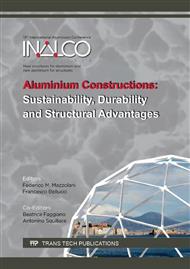p.115
p.121
p.127
p.137
p.143
p.149
p.155
p.163
p.169
Macroscopic Modelling of Flow-Drill Screw Connections
Abstract:
This study focuses on the modelling of Flow-Drill Screw (FDS) connections in large-scale shell analyses. Macroscopic connection models for large-scale crash simulations were assessed for modelling of FDS connections between two aluminium plates. Of the investigated models were two commercial element-based and three commercial constraint-based models, as well as two new user-defined element-based models. All models were calibrated using cross tests in tension, shear and a mixed shear/tension mode. In order to assess the flexibility of the models two sets of experimental data were used. In the first one, a small screw was used to join two sheets of the same rolled alloy while the second set used a longer screw with a larger head to join a rolled alloy to an extrusion. The calibrated models were validated using a two-step approach involving benchmark and component tests. Of the commercial models, the constraint-based performed better than the element-based. The new user-defined models gave similar results as the commercial constraint-based models. From the obtained results, recommendations for modelling of FDS connections for large-scale analyses were formulated.
Info:
Periodical:
Pages:
143-148
Citation:
Online since:
September 2016
Authors:
Keywords:
Price:
Сopyright:
© 2016 Trans Tech Publications Ltd. All Rights Reserved
Share:
Citation:


